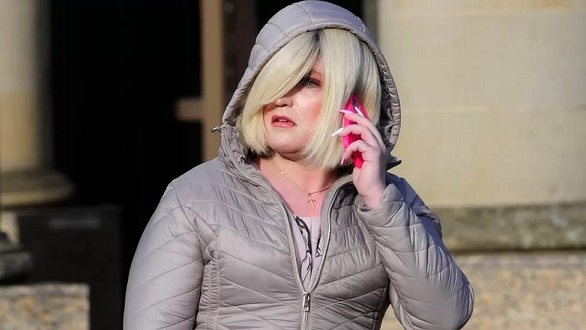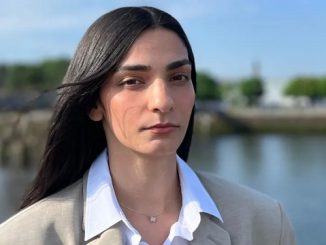
Sending a transgender rapist to a women’s prison was an “unnecessary shambles”, its former governor said.
Rhona Hotchkiss, who ran Cornton Vale until 2017, said she would have refused to have Isla Bryson at the prison.
Bryson, 31, was remanded to the jail in Stirling after being convicted of raping two women before she changed gender. Bryson began transitioning from a man to a woman while awaiting trial.
She was moved to HMP Edinburgh men’s prison on Thursday.
It came after First Minister Nicola Sturgeon announced that Bryson would not be allowed to serve her term at Cornton Vale.
She is due to be sentenced next month for raping a woman in 2016 and another in 2019, with concerns being raised about the potential safety implications of housing her alongside female prisoners.
It has also emerged that Bryson had enrolled on a beauty course at Ayrshire College after being charged with the two rapes.
A female student who was on the same course told the Daily Record newspaper that students had been unaware Bryson was awaiting trial, with others saying Bryson had been “overpowering” and “disruptive”.
The newspaper reported that classmates were repeatedly being branded homophobic by Bryson, who was finally asked to leave the course.
One of the students said: “Being a beauty course, you need to take your clothes off for some of it. We were doing spray tanning at one point and I was a model. You need to stand practically naked.”
The college said it too had been unaware of the allegations against Bryson during her three months on the course in 2021.
Bryson was initially held at Cornton Vale during a 72-hour segregated assessment period this week after being convicted of rape on Tuesday.
Ms Hotchkiss said the row over her detention was an “unnecessary shambles” that could have been avoided with specialist units for transgender inmates.
She told BBC Scotland: “I would have refused to have this person in Cornton Vale, I’m afraid. It just goes against all natural justice.
“I would have insisted there was no reason for this person to be assessed in Cornton Vale.
“It’s wrong to use segregation when it’s not strictly necessary and in my opinion that’s what has happened here.”
Isla Bryson was arrested by police after committing the crimes in Clydebank and Glasgow in 2016 and 2019 while known as Adam Graham.
The case is believed to be the first time a trans woman has been convicted of raping women in Scotland.
The Scottish Prison Service (SPS) said it considers the risks posed by and to the individual prisoner when deciding where they are sent.
Under a policy introduced by the Scottish Prison Service in 2014, the question of where trans prisoners are housed should “usually” be based on the gender which they identify as.
But the guidelines, which were developed with the Scottish Trans Alliance, do not give an automatic right for transgender prisoners to be accommodated according to their acquired gender, with decisions made on a case-by-case basis subject to risk assessments.

Ms Hotchkiss, a longstanding critic of the Scottish government’s gender reforms, suggested situations such as Bryson’s would become a “bigger problem” if the Gender Recognition Reform Bill was enacted.
The bill has been blocked by the UK government over its potential impact on equality laws that apply across Scotland, England and Wales.
Ms Hotchkiss said: “If you can get a Gender Recognition Certificate within three months (instead of the current two years), lots of male prisoners will do it.”
She added: “We need third units for trans people and they should be in male prisons.”
Ms Hotchkiss said it was “simply not acceptable” to allow all trans prisoners to go to a jail matching their gender identity.
She told BBC Scotland: “It’s unbalancing rights. They are not considering the rights of women, they are only considering one side of this equation. It seems to me quite wrong.”
Another former Scottish prison governor, David Wilson, told BBC Scotland’s the Nine that he had been involved in managing a number of transitioning prisoners during his career, which had been done on an “ad-hoc basis” – a strategy he said could no longer be coped with.
He added: “There’s going to have to be a much more concerted plan in relation to how to deal with transitioning prisoners, and that probably means setting up a special unit for those prisoners or a special wing.
“It’s not something that’s so unusual – we now have special units that are basically being run in our prisons as hospices because we now have so many older prisoners in our prison population. I don’t see this as any different from that.”
Sarah Armstrong, a professor of criminology at Glasgow University, said she was surprised that concern over the safety of women in prison was “focused on this one, very exceptional case” given the “scathing” reports from the European Committee on the Prevention of Torture after previous visits to Cornton Vale.
Prof Armstrong said: “We hear the committee saying women are being held in segregation for such long periods and with no mental health support – one women gnawed her arm to the bone. I’d love to hear those who care about the safety of women showing up for the issues that are really facing women in prison.”
Scottish Justice Secretary Keith Brown said on Wednesday that he trusted the SPS to decide on the correct venue for trans prisoners.
And Nicola Sturgeon said her government had given no “formal direction” to the prison service on where Bryson should be held.
She added: “This individual case is not about whether they are trans or not, in this individual case this is a person who’s been convicted of rape, so this individual is a rapist and a sex offender and that is what’s important.”
Speaking on the News Agents podcast on Friday, Ms Sturgeon also claimed that some critics of her government’s gender recognition reforms had “decided to use women’s rights as a sort of cloak of acceptability to cover up what is transphobia”.
An SPS spokesman said decisions on where transgender prisoners were located were made “by a multi-disciplinary assessment of both risk and need”.
He added: “Such decisions seek to protect both the wellbeing and rights of the individual as well as the welfare and rights of others around them, including staff, in order to achieve an outcome that balances risks and promotes the safety of all.”
Source: bbc.co.uk






Be the first to comment